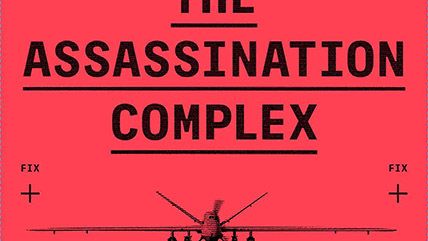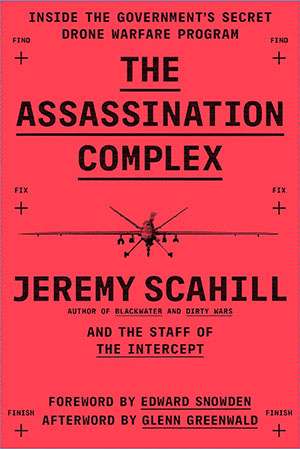Death from Above
Whistleblowers reveal the truth about the drone war to a nation that struggles to listen.

The Assassination Complex: Inside the Government's Secret Drone Warfare Program, by Jeremy Scahill and the staff of The Intercept, Simon & Schuster, 217 pages, $24.99

One summer day in 2013, NBC reporters Richard Engel and Robert Windrem unveiled a lengthy news story revealing a dark truth about America's use of drones to fight terrorists overseas: The CIA did not really know who it was killing with strikes in Pakistan, but it was classifying them all as "other militants" anyway.
Readers may be forgiven for not remembering this exposé. It was released on June 5, the same day Glenn Greenwald, in The Guardian, published the first of an explosive series of stories detailing how Western intelligence agencies were using mass surveillance systems to track and store enormous amounts of private data about their citizens. Even before former National Security Agency contractor Edward Snowden outed himself as Greenwald's source, the coverage led to a massive media blitz and to related revelations by other outlets. NBC couldn't compete for attention.
Engel and Windrem were not the first reporters to cover the dark side of the drone wars, and they haven't been the last. Jeremy Scahill (author of Dirty Wars and Blackwater) and the staff of The Intercept, where Greenwald is now an editor, are the latest to receive, analyze, and disseminate secret information about America's program of drone assassinations. Like NBC's report, their book, The Assassination Complex, shows how Washington's drones are killing civilians in such countries as Pakistan and Yemen. To conceal the potentially unpleasant repercussions of these strikes, the administration—when not stonewalling attempts at transparency entirely—classifies these deaths as "enemies killed in action," or EKIAs, though it is actually often unsure of these people's identities. The designation is changed only when posthumous evidence proves those killed by drones were definitively not members of terrorist cells.
With the help of confidential documents leaked to The Intercept, the book is able to offer some hard numbers. In a yearlong operation in northeastern Afghanistan, the United States killed more than 200 people; only 35 were intended targets. The source who leaked the documents explained: "Anyone caught within the vicinity is guilty by association," but "there is no guarantee that those persons deserved their fate…so it's a phenomenal gamble."
Regardless of the success rate of that gamble, it appears to have become the status quo. Two competing pressures have made it so. One is the push to protect Americans from radical forces gathering in the Middle East. The second is the demand that, in the wake of the wars in Iraq and Afghanistan, the president reduce the footprint of actual U.S. troops in these areas. Adm. Dennis Blair, a former director of national intelligence, sums it up: "It is the politically advantageous thing to do—low cost, no U.S. casualties, gives the appearance of toughness. It plays well domestically, and it is unpopular only in other countries. Any damage it does to the national interest only shows up over the long term."
The trade-offs that reduce the risks faced by American troops also contribute directly to the likelihood that innocent civilians will be killed in these strikes. The government has become extremely reliant on SIGINT, or "signals intelligence"—what the rest of us refer to as surveillance. Hunting targets is increasingly done not with eyes on the ground but by tracking their communications. A human being may technically be the target, but it's the person's phone that's actually being tracked and that will tell the drone pilots where to launch the attack. They have a very limited view of what is actually happening where they're striking, making it even more likely that civilians or other unrelated people will be injured or killed. One analyst determined that drone strikes were 10 times more likely to kill civilians than raids by manned aircraft.
There are more subtle trade-offs as well. Because drone strikes are likely to be more lethal than aircraft raids or military assaults on the ground, there is very little to no possibility that new intelligence can be gained. There are no survivors to interrogate, and there are no people there to perform the task anyway. Drone strikes create intelligence dead ends, thus reinforcing the need to rely on signals intelligence. And so the cycle continues.
The Assassination Complex also includes some reporting on surveillance issues not directly related to drone warfare. This is intended to help Americans understand how it all connects to how the government treats us at home. Of the 12 chapters, three—again based on leaks—explore how America's various terrorist "watch lists" work and how law enforcement's surveillance technology tracks phone locations.
The watch lists are supposed to be tools to help officials keep an eye on terror suspects. Those who end up on the lists are singled out for more thorough searches when flying, and they may even earn a place on the infamous "no fly" list. But The Intercept discovered that the majority of the people on these lists—close to 300,000 of them—have no known connection to recognized terrorist groups.
With its chapters on watch lists and police surveillance, the authors warn us that tools developed to fight threats against America can easily be adapted to be used against Americans. Such concerns prompted Sen. Rand Paul (R–Ky.) to launch a 13-hour filibuster back in 2013, temporarily blocking the nomination of John Brennan to head the CIA and drawing attention to the secrecy, lack of due process, and lack of oversight in America's drone program.
It's worth pondering why America's drone killings haven't stirred the sort of outrage that Snowden's leaks inspired. (Snowden, incidentally, contributes a forward to this book.) While The Assassination Complex's primary sources remain anonymous, actual former drone pilots such as Brandon Bryant, who is quoted, have come forward to criticize the way the programs operate. Yet he is nowhere near as famous as Snowden.
In the afterword, Greenwald acknowledges that Americans mostly favor the use of drones in the war on terror. But that support isn't monolithic. He points to a poll from 2012 showing 77 percent of self-described liberal Democrats supporting drone strikes on suspected terrorists. But a more recent Pew Research poll, from 2015, has 58 percent of the country endorsing such strikes, including a little more than half of Democrats.
While a majority still supports the strikes, that's nevertheless a notable drop in a short timespan. Debate over the use of drone strikes may not be making household names out of its critics, but documentation like The Assassination Complex helps readers understand that a hands-off war still has costs—and may not be making us as safe as we want to believe.
This article originally appeared in print under the headline "Death from Above."


Show Comments (28)